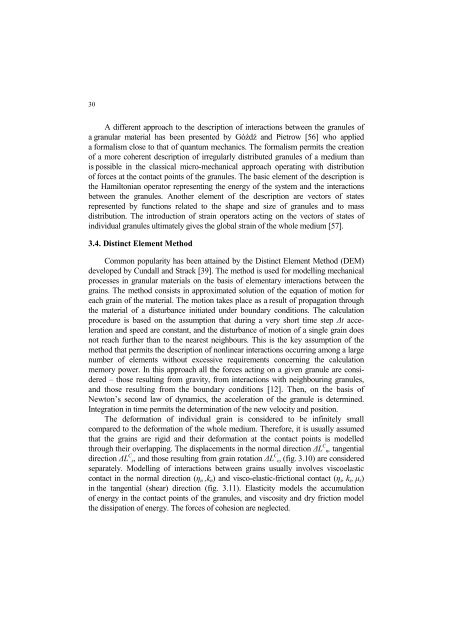Strona 2_redak - Instytut Agrofizyki im. Bohdana DobrzaÅskiego ...
Strona 2_redak - Instytut Agrofizyki im. Bohdana DobrzaÅskiego ...
Strona 2_redak - Instytut Agrofizyki im. Bohdana DobrzaÅskiego ...
Create successful ePaper yourself
Turn your PDF publications into a flip-book with our unique Google optimized e-Paper software.
30<br />
A different approach to the description of interactions between the granules of<br />
a granular material has been presented by Góźdź and Pietrow [56] who applied<br />
a formalism close to that of quantum mechanics. The formalism permits the creation<br />
of a more coherent description of irregularly distributed granules of a medium than<br />
is possible in the classical micro-mechanical approach operating with distribution<br />
of forces at the contact points of the granules. The basic element of the description is<br />
the Hamiltonian operator representing the energy of the system and the interactions<br />
between the granules. Another element of the description are vectors of states<br />
represented by functions related to the shape and size of granules and to mass<br />
distribution. The introduction of strain operators acting on the vectors of states of<br />
individual granules ult<strong>im</strong>ately gives the global strain of the whole medium [57].<br />
3.4. Distinct Element Method<br />
Common popularity has been attained by the Distinct Element Method (DEM)<br />
developed by Cundall and Strack [39]. The method is used for modelling mechanical<br />
processes in granular materials on the basis of elementary interactions between the<br />
grains. The method consists in approx<strong>im</strong>ated solution of the equation of motion for<br />
each grain of the material. The motion takes place as a result of propagation through<br />
the material of a disturbance initiated under boundary conditions. The calculation<br />
procedure is based on the assumption that during a very short t<strong>im</strong>e step ∆t acceleration<br />
and speed are constant, and the disturbance of motion of a single grain does<br />
not reach further than to the nearest neighbours. This is the key assumption of the<br />
method that permits the description of nonlinear interactions occurring among a large<br />
number of elements without excessive requirements concerning the calculation<br />
memory power. In this approach all the forces acting on a given granule are considered<br />
– those resulting from gravity, from interactions with neighbouring granules,<br />
and those resulting from the boundary conditions [12]. Then, on the basis of<br />
Newton’s second law of dynamics, the acceleration of the granule is determined.<br />
Integration in t<strong>im</strong>e permits the determination of the new velocity and position.<br />
The deformation of individual grain is considered to be infinitely small<br />
compared to the deformation of the whole medium. Therefore, it is usually assumed<br />
that the grains are rigid and their deformation at the contact points is modelled<br />
through their overlapping. The displacements in the normal direction ∆L C n, tangential<br />
direction ∆L C s, and those resulting from grain rotation ∆L C ω (fig. 3.10) are considered<br />
separately. Modelling of interactions between grains usually involves viscoelastic<br />
contact in the normal direction (η n ,k n ) and visco-elastic-frictional contact (η s , k s , µ s )<br />
in the tangential (shear) direction (fig. 3.11). Elasticity models the accumulation<br />
of energy in the contact points of the granules, and viscosity and dry friction model<br />
the dissipation of energy. The forces of cohesion are neglected.
















